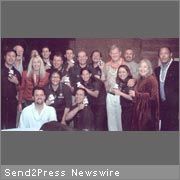In a revolutionary leap that could transform solar power from a marginal, boutique alternative into a mainstream energy source, MIT researchers have overcome a major barrier to large-scale solar power: storing energy for use when the sun doesn't shine.
Daniel Nocera describes new process for storing solar energy
View video post on MIT TechTV
Until now, solar power has been a daytime-only energy source, because storing extra solar energy for later use is prohibitively expensive and grossly inefficient. With today's announcement, MIT researchers have hit upon a simple, inexpensive, highly efficient process for storing solar energy.
Requiring nothing but abundant, non-toxic natural materials, this discovery could unlock the most potent, carbon-free energy source of all: the sun. "This is the nirvana of what we've been talking about for years," said MIT's Daniel Nocera, the Henry Dreyfus Professor of Energy at MIT and senior author of a paper describing the work in the July 31 issue of Science. "Solar power has always been a limited, far-off solution. Now we can seriously think about solar power as unlimited and soon."
Inspired by the photosynthesis performed by plants, Nocera and Matthew Kanan, a postdoctoral fellow in Nocera's lab, have developed an unprecedented process that will allow the sun's energy to be used to split water into hydrogen and oxygen gases. Later, the oxygen and hydrogen may be recombined inside a fuel cell, creating carbon-free electricity to power your house or your electric car, day or night.
The key component in Nocera and Kanan's new process is a new catalyst that produces oxygen gas from water; another catalyst produces valuable hydrogen gas. The new catalyst consists of cobalt metal, phosphate and an electrode, placed in water. When electricity -- whether from a photovoltaic cell, a wind turbine or any other source -- runs through the electrode, the cobalt and phosphate form a thin film on the electrode, and oxygen gas is produced.
Combined with another catalyst, such as platinum, that can produce hydrogen gas from water, the system can duplicate the water splitting reaction that occurs during photosynthesis.
The new catalyst works at room temperature, in neutral pH water, and it's easy to set up, Nocera said. "That's why I know this is going to work. It's so easy to implement," he said.
'Giant leap' for clean energy
Sunlight has the greatest potential of any power source to solve the world's energy problems, said Nocera. In one hour, enough sunlight strikes the Earth to provide the entire planet's energy needs for one year.
James Barber, a leader in the study of photosynthesis who was not involved in this research, called the discovery by Nocera and Kanan a "giant leap" toward generating clean, carbon-free energy on a massive scale.
"This is a major discovery with enormous implications for the future prosperity of humankind," said Barber, the Ernst Chain Professor of Biochemistry at Imperial College London. "The importance of their discovery cannot be overstated since it opens up the door for developing new technologies for energy production thus reducing our dependence for fossil fuels and addressing the global climate change problem."
'Just the beginning'
Currently available electrolyzers, which split water with electricity and are often used industrially, are not suited for artificial photosynthesis because they are very expensive and require a highly basic (non-benign) environment that has little to do with the conditions under which photosynthesis operates.
More engineering work needs to be done to integrate the new scientific discovery into existing photovoltaic systems, but Nocera said he is confident that such systems will become a reality.
"This is just the beginning," said Nocera, principal investigator for the Solar Revolution Project funded by the Chesonis Family Foundation and co-Director of the Eni-MIT Solar Frontiers Center. "The scientific community is really going to run with this."
Nocera hopes that within 10 years, homeowners will be able to power their homes in daylight through photovoltaic cells, while using excess solar energy to produce hydrogen and oxygen to power their own household fuel cell. Electricity-by-wire from a central source could be a thing of the past.
The project is part of the MIT Energy Initiative, a program designed to help transform the global energy system to meet the needs of the future and to help build a bridge to that future by improving today's energy systems. MITEI Director Ernest Moniz, Cecil and Ida Green Professor of Physics and Engineering Systems, noted that "this discovery in the Nocera lab demonstrates that moving up the transformation of our energy supply system to one based on renewables will depend heavily on frontier basic science."
The success of the Nocera lab shows the impact of a mixture of funding sources - governments, philanthropy, and industry. This project was funded by the National Science Foundation and by the Chesonis Family Foundation, which gave MIT $10 million this spring to launch the Solar Revolution Project, with a goal to make the large scale deployment of solar energy within 10 years.


 Professor Schneider has been chief writer on IPCC’s Team for 20 years, Aspen SkiCo’s consultant, Squaw Valley’s climate conference speaker, and Tom Brokaw’s expert on his HBO Global Warming Special. The Nobel Laureate bikes to work and uses natural household products as cancer and pollution prevention, given its link to glacier melting (ref:
Professor Schneider has been chief writer on IPCC’s Team for 20 years, Aspen SkiCo’s consultant, Squaw Valley’s climate conference speaker, and Tom Brokaw’s expert on his HBO Global Warming Special. The Nobel Laureate bikes to work and uses natural household products as cancer and pollution prevention, given its link to glacier melting (ref: 



